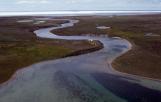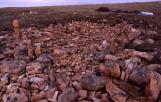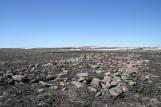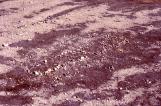1
The Canadian Arctic was populated by two waves of migration. The first wave, known as Palaeo-Eskimo, came around 4-5000 years ago, and the second wave, known as Thule, came around 1000 years ago. Each group of migrants had their own distinctive technologies and traditions which are studied by archaeologists.The history surrounding the Cambridge Bay region goes back as far as 4000 years ago, and ranges from Pre-Dorset Culture to Modern Inuit Culture. The prehistory of the area is currently being studied by Dr. Max Friesen, an archaeologist at the University of Toronto. He was contacted six years ago by the Kitikmeot Heritage Society (KHS) to investigate archaeological sites in the Iqaluktuuq region, not far from Cambridge Bay. Ever since then, Dr. Friesen has been returning to conduct archaeological excavations every summer.
3
Iqaluktuuq, means "place of big fish", is located Northwest of Cambridge Bay. This location served as an Inuit hunting and fishing ground for many years, and is still used today. The area of Iqaluktuuq is particularly important to researchers, such as archaeologists, because it contains numerous prehistoric sites that inform us about the culture of Inuit and their ancestors.This picture was taken by archaeologist Dr. Max Friesen, and shows the Iqaluktuuq Region, extending along the river from Ferguson Lake, at the bottom, to Wellington Bay, in the distance. Both banks of the river contain numerous archaeological sites that range from Pre-Dorset culture (1800 BC) to Thule culture (1500AD).
5
The Pre-Dorset (1800 B.C.to 500 B.C.) were the first people who arrived in the unpopulated landscape of the Canadian Arctic about 4000 years ago. The Pre-Dorset were people who lived by hunting and fishing. They hunted caribou and musk oxen on land and seals and walruses during winter. Compared to the Inuit, the Pre-Dorset do not seem well-prepared for winter. Their camps were small, and they lived only in tents year round, heated by small open fires made of arctic willow, driftwood, heather, and animal bones and fat.Photo taken by M. Friesen.
7
As the arctic climate began to change around 2500 years ago, so did the Tuniit way of life. The Arctic became very cold, thus changing the distribution of animals. To survive, the Tuniit improved their techniques for hunting sea-mammals such as, seal, walrus, beluga, and narwhals. They also developed new types of harpoon heads. Other implements, such as, sled shoes of bone and ivory, and large knives for cutting snow were also invented. Technologies, such as the bow and arrow, were suddenly abandoned by the Tuniit. Tuniit culture is known by archaeologists as the Dorset Culture (500 B.C to 1250 A.D).Location: Ferguson Lake, Victoria Island, Nunavut
The Ferguson Lake site contains an Early Dorset semi-subterranean house. The standing boulders mark the corners of the house. The entrance of the house is located at the lower right corner of the picture, behind which you can see the excavated house floor.
This house was probably occupied 2500 years ago by people who mainly lived on caribou meat stored in the fall after the hunting season.
Photo by M. Friesen.
9
This is a Dorset harpoon foreshaft from the Buchanan site. It is probably about 2000 years old. It is made out of antler, and would have been attached to the end of a wooden harpoon shaft.Photo by M. Friesen.
11
Microblades are tiny stone tools that are no more than 10mm in width. They are one of the most common tools manufactured during the Pre-Dorset and Dorset periods. These tools are very sharp on the edges, and were therefore effective for slicing meat, cutting skin, and butchering.The stone microblades and the microblade core shown in the picture were found at the Dorset Buchanan site.
Photo by M. Friesen.
13
Late Dorset Culture (800 A.D to 1250 A.D.)Location: Cambridge Bay, Victoria Island, Nunavut
This is a late Dorset longhouse at the Ekvana site (just a little North of Cambridge Bay) and it is about 1000 years old. It was occupied by people who gathered during the summer to trade, exchange information, and meet up with relatives who were dispersed during other seasons.
Photo by W. Kok.






